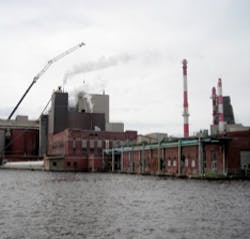Milling About
NewPage operates eight paper mills in the United States. The Biron mill located in Wisconsin Rapids, Wis., produces approximately 370,000 tons of paper each year.
Water production required from the filter plant ranges from 6 to 10 mgd, with approximately 6,000 gal of filtered water being required for each ton of paper produced. The water for use within the mill is drawn directly from the Wisconsin River, where alum and polymer are added prior to an Accelator clarifier. Chlorine is then added to the clarified water prior to the water entering a Leopold filtration system.
Project background
The plant was originally designed in the 1950s with a filtration system comprised of ten filter cells. Four dual-cell filters were retrofitted with Leopold clay tile underdrains in the early 1980s, and these filters produced the majority of the water for the Biron mill.
In late 2012, production capacity questions issues arose with several of the clay tile filters. An investigation revealed that the gravel in these filters had been displaced, allowing sand and anthracite to pass into the clay tile underdrain, reducing the capacity of the filter cells. Through the investigation, the process engineers at the paper mill worked to pinpoint the filters in the direst need of rehabilitation.
Solution
Leopold proposed retrofitting two of the four dual-cell filters with the Leopold Type S underdrain system utilizing the I.M.S. 200 media retainer. Leopold engineers customized the filter media profile to meet the needs of the facility.
Leopold provided the Type S underdrain system and media retainer with the flexibility of using up to 33 in. total depth of monomedia anthracite (0.75 to 0.85 mm) for this hydraulic-only system. The larger anthracite met the production and water quality demands of the Biron mill.
The operation staff chose to utilize 28 in. of the monomedia anthracite to reduce the potential for media loss. Air stubs were incorporated on the underdrain for the possibility of adding air scour to the system in the future in an effort to further increase backwash efficiency and filter run times.
Result
Prior to the rehab, the two dual-cells in question were producing approximately 1.2 mgd each. Following the rehab, the two new dual-cell filters produce the majority of the load required at the facility and reach capacities of up to 2.5 mgd each. This equates to a greater than 100% capacity increase for each. These filters are now able to manage approximately half the workload required at the mill.
Along with increased capacity, the filter effluent water quality has also improved, which will lead to fewer plant shutdowns caused by seal failures within the mill. Consistent water quality is important in the operations at the mill. If the filtered effluent is not held to a particular standard, issues can arise when floc or particulates plug the flow to the pump seals, causing them to fail. When this failure occurs, it requires a maintenance emergency to avoid plant shutdown and system downtime.
Filter effluent turbidity from the rehabilitated filters is approximately 0.13 ntu, and apparent color ranges from 0 to 1 Pt/Co. The requirement for these filters are that of a roughing filter, where water effluent turbidities of less than 3 ntu would be acceptable, although less than 1 ntu is preferred. Prior to the rehab, the two selected filters were producing water of greater than 1 ntu (essentially no filtration from the clarifier), as the water tended to flow through large cracks or voids in the filter media.
